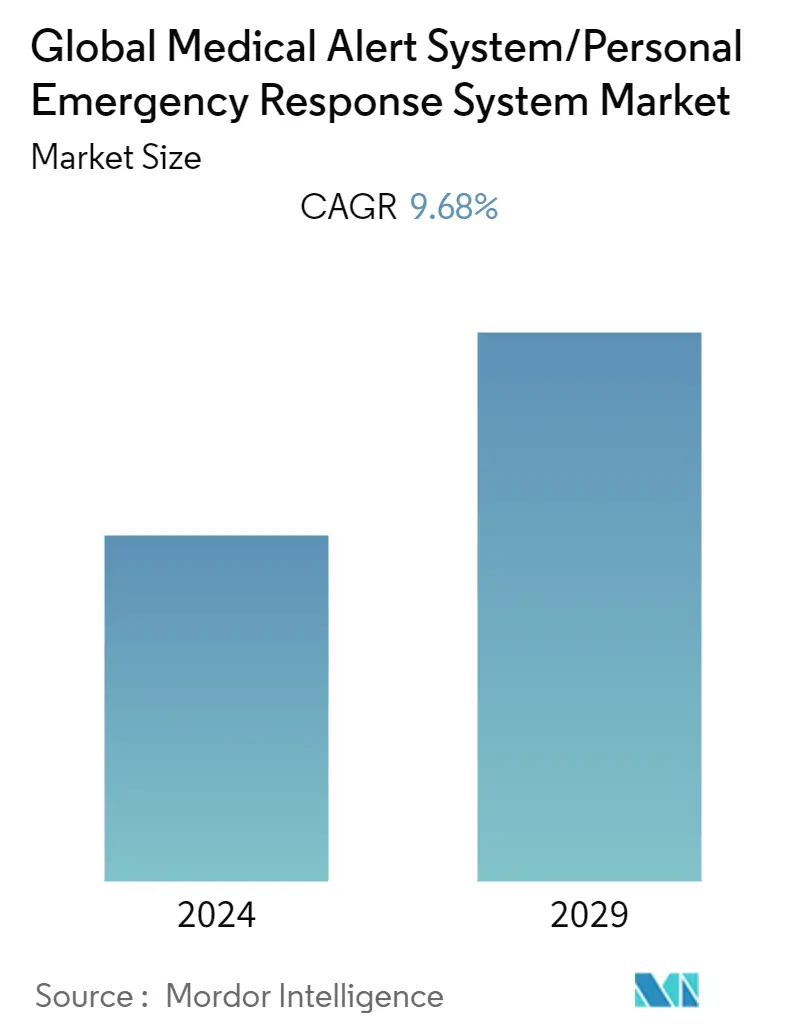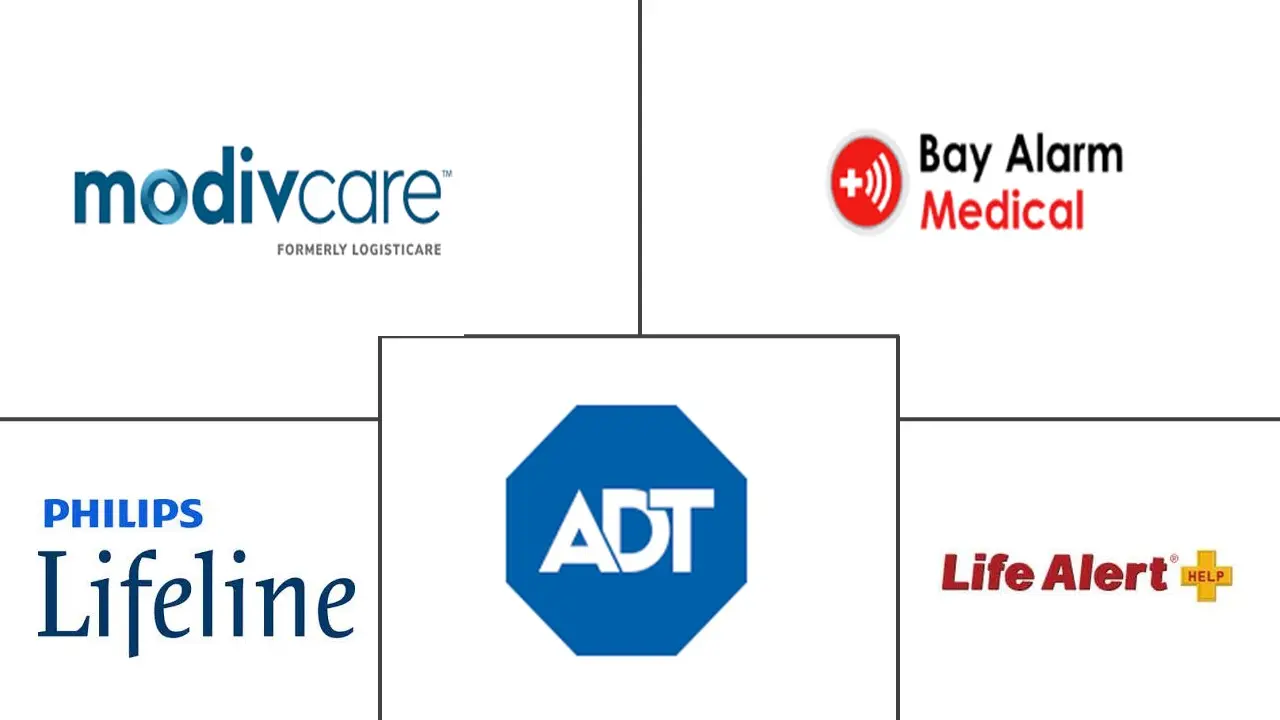Market Size of Global Medical Alert System/Personal Emergency Response System Industry

| Study Period | 2019 - 2029 |
| Base Year For Estimation | 2023 |
| Forecast Data Period | 2024 - 2029 |
| CAGR | 9.68 % |
| Fastest Growing Market | Asia Pacific |
| Largest Market | North America |
Major Players
*Disclaimer: Major Players sorted in no particular order |
Personal Emergency Response System (PERS) Market Analysis
The Medical Alert System/Personal Emergency Response System Market is poised to register a CAGR of 9.68% during the forecast period (2022-2027).
The medical alert system/personal emergency response system market was significantly impacted by COVID-19 due to an increase in the number of hospital admissions. According to the article published in Nature Communication in June 2021, medical alert systems have helped combat COVID-19 as there is a restriction on the movement of the COVID-19 patient. Thus Covid-19 has had a tremendous impact on the market.
The propelling factors for the growth of the medical alert system/personal emergency response system market include the increasing aging population, technological developments in healthcare wearables, increasing penetration of smartphones in healthcare and constant innovations in technology, and easy adaptability of PERS devices.
Medical alert systems are becoming increasingly popular as the elderly population grows. Personal emergency response systems (PERS) are primarily designed to allow the elderly and people with disabilities to summon assistance in an emergency quickly. According to the United Nations' revised World Population Prospects, the number of people aged 60 and up is expected to more than double by 2050, from 962 million in 2015 to 2.1 billion in 2050. This age group is at a higher risk of developing a variety of age-related illnesses that necessitate the use of personal mobility. According to Disabled World, approximately 10% of the world's population, or nearly 650 million people, live with a disability. In most OECD countries, females have higher rates of disability than males, and according to the UN Development Program (UNDP), 80% of persons with disabilities live in developing countries. As a result, the elderly can age in the comfort of their own homes with the help of medical alert systems, and this factor is likely to propel the overall market forward.
The current market is also growing due to the increasing adoption of smartphones. The global smartphone penetration is estimated at an all-time high; thus, smartphones are crucial in one's daily life, which is a major factor in the market's growth. For instance, in December 2019, Arvi, a health tech firm, launched a smart medical alert system for senior citizens in India. The smart medical alert system offers emergency and non-emergency medical assistance with doorstep convenience for senior citizens. It aims to make healthcare easy, instant, and accessible for senior citizens.
In recent years, the wearable health industry has exploded, and this trend is expected to continue in the coming years. These wearables are used to track people's health and well-being. In addition, there are technological advancements in wearables that may help patients to adopt medical systems in the coming years.
Personal Emergency Response System (PERS) Industry Segmentation
As per the scope of the report, personal emergency response systems (PERS), also known as medical emergency response systems, allow users to call for help during an emergency by pushing a button. Therefore, due to the rapid increase in the elderly population, there is a growing need for medical alert systems. The Medical Alert System/Personal Emergency Response System Market is segmented by Type (Landline PERS, Mobile PERS, and Other Types), End User (Home-based Users, Assisted Living Facilities, Others), and Geography (North America, Europe, Asia-Pacific, Middle East & Africa, and South America). The market report also covers the estimated market sizes and trends for 17 countries across major global regions. The report offers the value (USD million) for the above segments.
| By Type | |
| Landline PERS | |
| Mobile PERS | |
| Other Types |
| By End User | |
| Home-based Users | |
| Assisted Living Facilities | |
| Others |
| Geography | ||||||||
| ||||||||
| ||||||||
| ||||||||
| ||||||||
|
Global Medical Alert System/Personal Emergency Response System Market Size Summary
The Personal Emergency Response System (PERS) market is experiencing significant growth, driven by the increasing aging population and advancements in healthcare technology. These systems are designed to assist the elderly and individuals with disabilities in summoning help during emergencies, thereby enhancing their independence and safety. The market has been notably influenced by the COVID-19 pandemic, which highlighted the importance of such systems as they facilitated remote monitoring and assistance for patients with restricted mobility. The proliferation of smartphones and wearable health technologies has further propelled the market, as these devices integrate seamlessly with PERS, offering enhanced features like real-time tracking and health monitoring. The demand for mobile PERS, which operate on cellular networks, is particularly strong due to their portability and advanced capabilities, making them a preferred choice for many users.
Regionally, Asia-Pacific is anticipated to be the fastest-growing market, fueled by a burgeoning geriatric population and a rising prevalence of chronic diseases. The need for improved healthcare infrastructure and home-based health programs is also contributing to market expansion in this region. In the United States, the increasing number of older adults and individuals with disabilities is driving the demand for medical alert systems, as these populations are more susceptible to mobility-related health issues. Key players in the market, such as ADT Corporation, Bay Alarm Medical, and Philips Lifeline, are actively expanding their product offerings and engaging in strategic collaborations to enhance their market presence. Innovations like Amazon's Alexa Together and Medical Guardian's Mini Guardian exemplify the ongoing advancements in PERS technology, catering to the evolving needs of the elderly and disabled populations.
Global Medical Alert System/Personal Emergency Response System Market Size - Table of Contents
-
1. MARKET DYNAMICS
-
1.1 Market Overview
-
1.2 Market Drivers
-
1.2.1 Increasing Aging Population across the World
-
1.2.2 Technological Developments in Healthcare Wearables
-
1.2.3 Constant Innovations in Technology and Easy Adaptability of PERS Devices
-
-
1.3 Market Restraints
-
1.3.1 Overall Cost Associated with the System is High
-
1.3.2 Lack of Know-how Pertaining to the New Technologies used in the PERS System
-
-
1.4 Porter's Five Forces Analysis
-
1.4.1 Threat of New Entrants
-
1.4.2 Bargaining Power of Buyers/Consumers
-
1.4.3 Bargaining Power of Suppliers
-
1.4.4 Threat of Substitute Products
-
1.4.5 Intensity of Competitive Rivalry
-
-
-
2. MARKET SEGMENTATION
-
2.1 By Type
-
2.1.1 Landline PERS
-
2.1.2 Mobile PERS
-
2.1.3 Other Types
-
-
2.2 By End User
-
2.2.1 Home-based Users
-
2.2.2 Assisted Living Facilities
-
2.2.3 Others
-
-
2.3 Geography
-
2.3.1 North America
-
2.3.1.1 United States
-
2.3.1.2 Canada
-
2.3.1.3 Mexico
-
-
2.3.2 Europe
-
2.3.2.1 Germany
-
2.3.2.2 United Kingdom
-
2.3.2.3 France
-
2.3.2.4 Italy
-
2.3.2.5 Spain
-
2.3.2.6 Rest of Europe
-
-
2.3.3 Asia-Pacific
-
2.3.3.1 China
-
2.3.3.2 Japan
-
2.3.3.3 India
-
2.3.3.4 Australia
-
2.3.3.5 South Korea
-
2.3.3.6 Rest of Asia-Pacific
-
-
2.3.4 Middle-East and Africa
-
2.3.4.1 GCC
-
2.3.4.2 South Africa
-
2.3.4.3 Rest of Middle-East and Africa
-
-
2.3.5 South America
-
2.3.5.1 Brazil
-
2.3.5.2 Argentina
-
2.3.5.3 Rest of South America
-
-
-
Global Medical Alert System/Personal Emergency Response System Market Size FAQs
What is the current Global Medical Alert System/Personal Emergency Response System Market size?
The Global Medical Alert System/Personal Emergency Response System Market is projected to register a CAGR of 9.68% during the forecast period (2024-2029)
Who are the key players in Global Medical Alert System/Personal Emergency Response System Market?
ADT Corporation, Bay Alarm Medical, Philips Lifeline (Koninklijke Philips N.V.), Life Alert and MediVcare (VRI Inc.) are the major companies operating in the Global Medical Alert System/Personal Emergency Response System Market.

